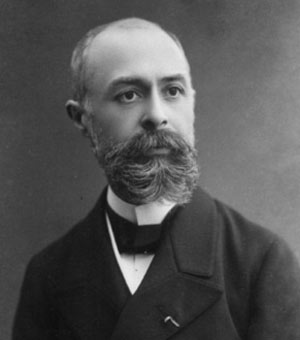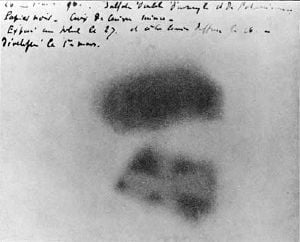Henri Becquerel
|
Antoine Henri Becquerel | |
|---|---|
 Antoine Becquerel, French physicist | |
| Born | |
| Died | August 25, 1908 Le Croisic, Brittany, France |
| Residence | |
| Nationality | |
| Field | Physicist |
| Institutions | Conservatoire des Arts et Metiers École Polytechnique Paris Museum |
| Alma mater | École Polytechnique École des Ponts et Chaussées |
| Known for | Radioactivity |
| Notable prizes | |
| Note that he is the father of Jean Becquerel, the son of A. E. Becquerel, and the grandson of
Antoine César Becquerel. | |
Antoine Henri Becquerel (December 15, 1852 – August 25, 1908) was a French physicist, Nobel laureate, and one of the discoverers of radioactivity.
Early days
Becquerel was born in Paris into a family which, including him and his son, produced four generations of scientists. He studied science at the École Polytechnique and engineering at the École des Ponts et Chaussées.
- Spouse: Louise Désirée Lorieux (m. 1890)
- Children: Jean
Rise in natural sciences, discoveries and major works
In 1892 he became the third in his family to occupy the physics chair at the Muséum National d'Histoire Naturelle. In 1894 he became chief engineer in the Department of Bridges and Highways.
In 1896, while investigating phosphorescence in uranium salts, Becquerel discovered radioactivity accidentally. Investigating the work of Wilhelm Conrad Röntgen, Becquerel wrapped a fluorescent mineral, potassium uranyl sulfate, in photographic plates and black material in preparation for an experiment requiring bright sunlight. However, prior to actually performing the experiment, Becquerel found that the photographic plates were fully exposed. This discovery led Becquerel to investigate the spontaneous emission of nuclear radiation.
Describing his method to the French Academy of Sciences on January 24, 1896, he said,
One wraps a Lumière photographic plate with a bromide emulsion in two sheets of very thick black paper, such that the plate does not become clouded upon being exposed to the sun for a day. One places on the sheet of paper, on the outside, a slab of the phosphorescent substance, and one exposes the whole to the sun for several hours. When one then develops the photographic plate, one recognizes that the silhouette of the phosphorescent substance appears in black on the negative. If one places between the phosphorescent substance and the paper a piece of money or a metal screen pierced with a cut-out design, one sees the image of these objects appear on the negative. … One must conclude from these experiments that the phosphorescent substance in question emits rays which pass through the opaque paper and reduces silver salts.[1][2]
In 1903 he shared the Nobel Prize in Physics with Pierre and Marie Curie "in recognition of the extraordinary services he has rendered by his discovery of spontaneous radioactivity".
Final days and legacy
In 1908, the year of his death, Becquerel was elected permanent secretary of the Académie des Sciences. He died at the age of 55 in Le Croisic.
The SI unit for radioactivity, the becquerel (Bq), is named after him, and there are Becquerel craters on the Moon and Mars.
- Rumford Medal (1900)
- Helmholtz Medal (1901)
- Nobel Prize for Physics (1903)
- Barnard Medal (1905)
See also
- A. E. Becquerel (his father)
- Antoine César Becquerel (his grandfather)
- Jean Becquerel (his son)
ReferencesISBN links support NWE through referral fees
- ↑ Henri Becquerel (1896). Sur les radiations émises par phosphorescence. Comptes Rendus 122: 420-421.
- ↑ Comptes Rendus 122, 420 (1896), translated by Carmen Giunta. Accessed September 10, 2006.
External links
- Henri Becquerel - Biography
- Becquerel short biography and the use of his name as an unit of measure in the SI
- Annotated bibliography for Henri Becquerel from the Alsos Digital Library for Nuclear Issues
| ||||||||
| Persondata | |
|---|---|
| NAME | Becquerel, Antoine Henri |
| ALTERNATIVE NAMES | |
| SHORT DESCRIPTION | French physicist |
| DATE OF BIRTH | December 15, 1852 |
| PLACE OF BIRTH | Paris, France |
| DATE OF DEATH | August 25, 1908 |
| PLACE OF DEATH | Le Croisic, Brittany, France |
bn:আঁতোয়ান অঁরি বেকেরেল bs:Henri Becquerel ca:Antoine Henri Becquerel cs:Henri Becquerel de:Antoine Henri Becquerel es:Henri Becquerel eo:Antoine Henri Becquerel fa:هانری بکرل fr:Henri Becquerel gl:Henri Becquerel ko:앙투안 앙리 베크렐 hi:ऑँरी बेकेरेल hr:Antoine Henri Becquerel io:Henri Becquerel id:Henri Becquerel is:Henri Becquerel it:Antoine Henri Becquerel he:אנרי בקרל sw:Antoine Henri Becquerel mk:Анри Бекерел nl:Antoine Henri Becquerel ja:アンリ・ベクレル no:Henri Becquerel nn:Henri Becquerel oc:Henri Becquerel pl:Henri Becquerel pt:Antoine Henri Becquerel ru:Беккерель, Антуан Анри sk:Antoine Henri Becquerel sl:Antoine Henri Becquerel sr:Анри Бекерел sh:Antoine Henri Becquerel fi:Henri Becquerel sv:Henri Becquerel th:อองรี เบ็กเกอเรล vi:Henri Becquerel tr:Henri Becquerel zh:亨利·贝克勒尔
